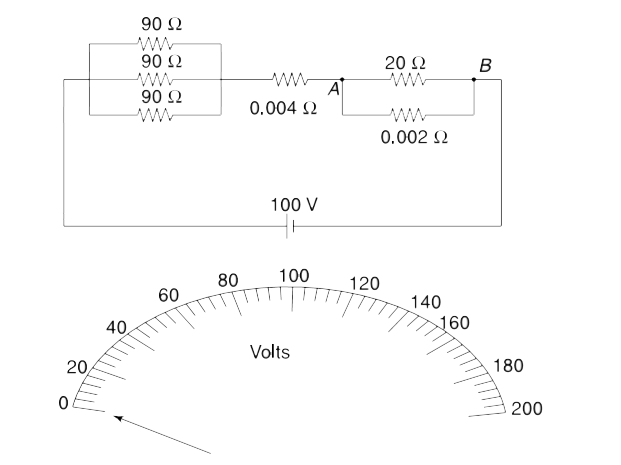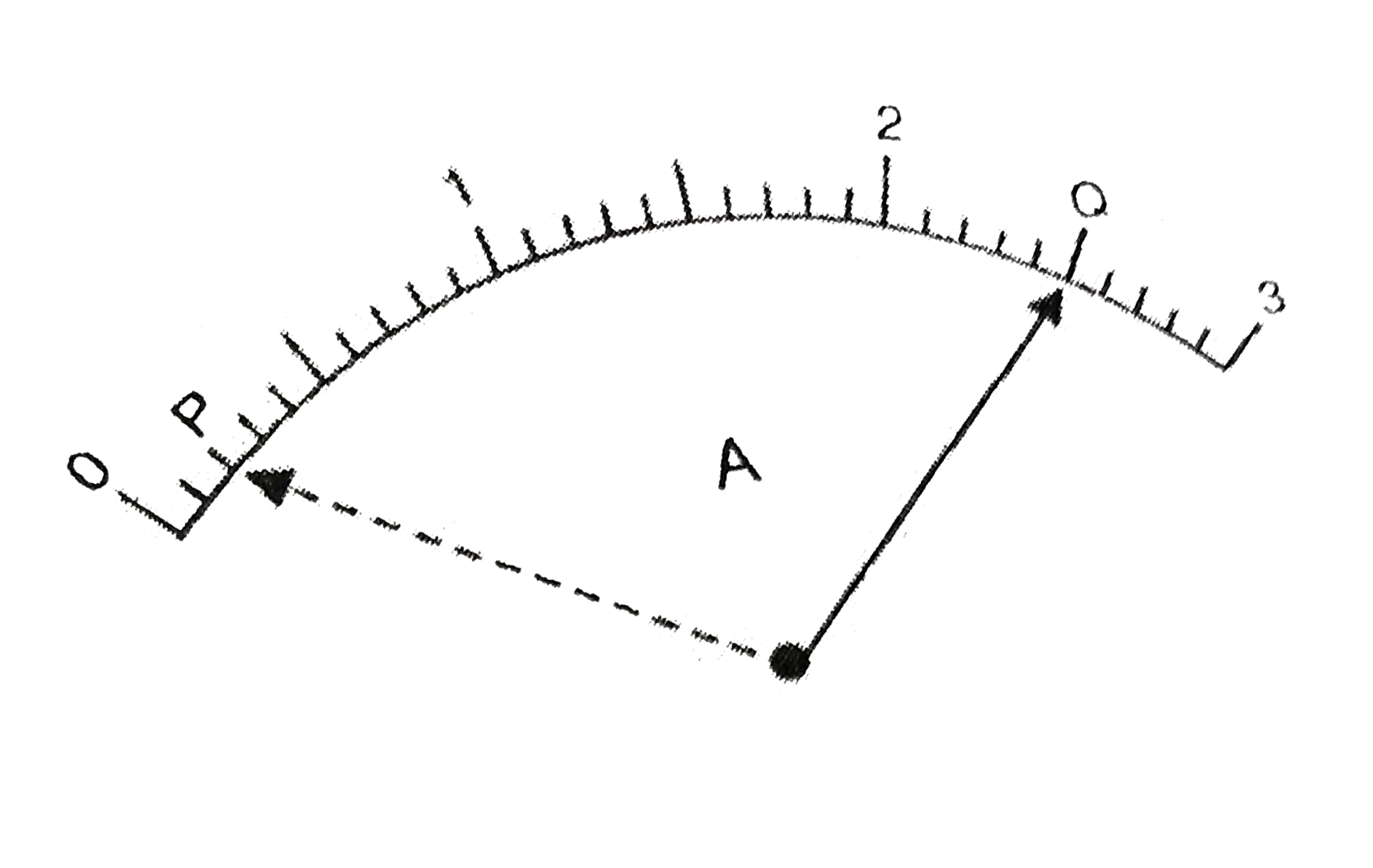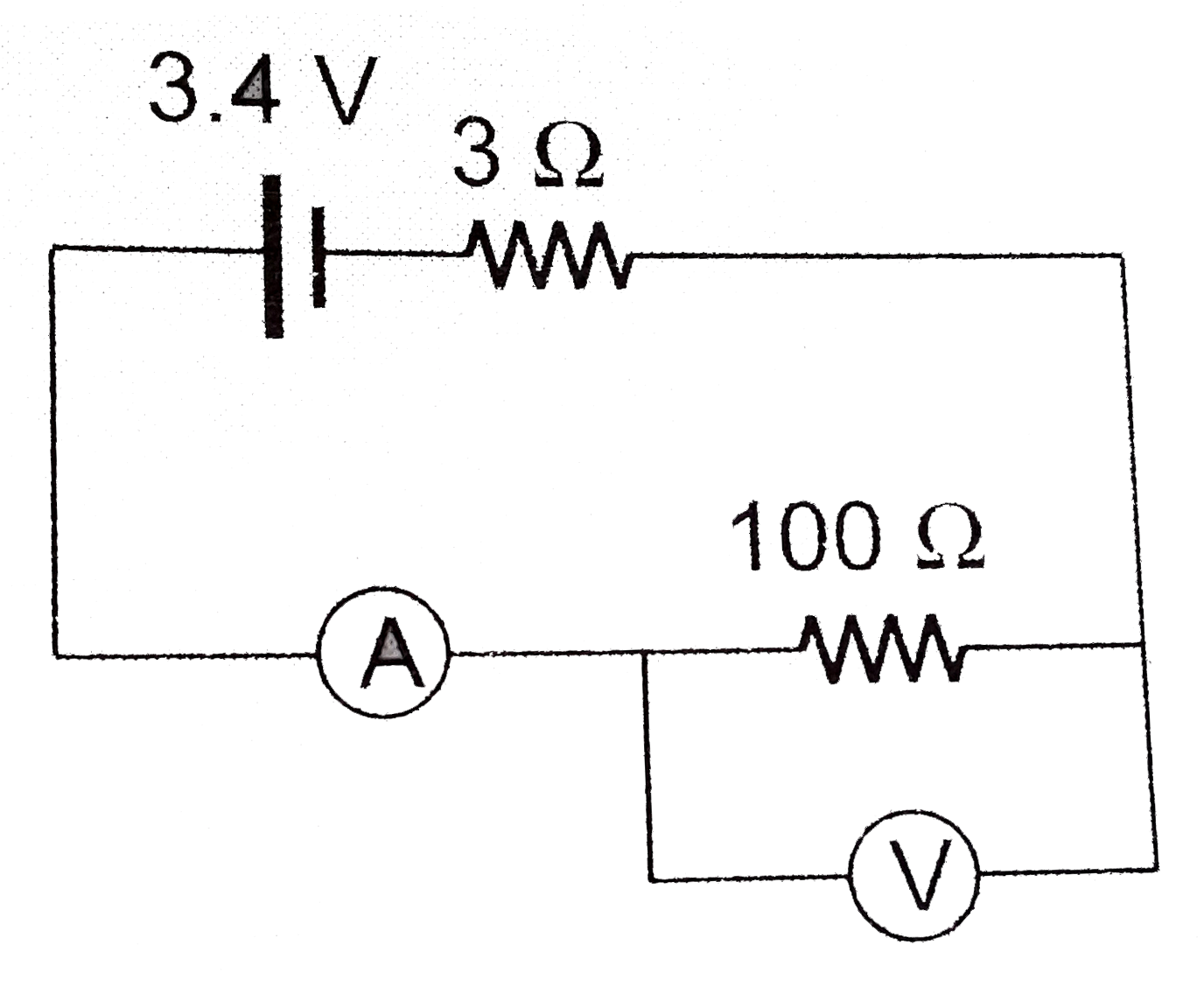What would you duggest to a student if while performing an experiment he finds that the
pointer/needle of the ammeter and woltmeter do not coincide with the zero marks on the
scales when circuit is open? No extra ammeter/voltmeter is available in the laboratory.
This is called the zero error of the scale of ammeter or voltmeter. If there is a zero error, then
this error is subtracted from the value that is depicted when the circuit is closed, otherwise,
the accurate current or potential difference will not be recorded.
Topper's Solved these Questions
- X BOARDSBOOK - X BOARDSCHAPTER - X BOARDSEXERCISE - SET-II SECTION-A
1 Videos
- X BOARDSBOOK - X BOARDSCHAPTER - X BOARDSEXERCISE - SET-II SECTION-C
1 Videos
- X BOARDSBOOK - X BOARDSCHAPTER - X BOARDSEXERCISE - SET-I SECTION-D
5 Videos
- SAMPLE QUESTION PAPER BOOK - X BOARDSCHAPTER - SAMPLE QUESTION PAPER EXERCISE - Section-B
11 Videos
Similar Questions
While performing an experiment by using a given voltmeter, a student observes that the needle indicates 12 divions on the voltmeter scale. If the voltmeter scale has 5 divisions between 0 and 1.V, then what is the value corresponding to 12 divisions ?
View SolutionA lab voltmeter has scale as shown in figure. A student uses this nearly ideal voltmeter to record potential difference between points A and B in the circuit shown. He could not see any deflection in the pointer and thinks that the voltmeter must be faulty. He replaces the voltmeter with another similar one. What reading will he record this time? Can you give some suggestion to record the potential difference across A and B ?

View Solution
Knowledge Check
A student while performing the experiment to find the resultant resistance of two resistors connected in series observes the ammeter pointer at position P when the key is 'off' and the same pointer at position Q when the key is 'on'.

The correct reading of ammeter is :A0.2 AB2.5 AC2.3 AD2.7 AThe following 'precautions' were listed by a student in the experiment on study of 'Dependence of current on potential difference'.
(A) Use copper wires as thin as possible for making connections.
(B) All the connections should be kept tight.
(C) The positive and negative terminals of the voltmeter and the ammeter should be correctly connected.
(D) The 'zero error' in the ammeter and the voltmeter should be noted and taken into consideration while recording the measurements.
(E) The 'key' in the circuit, once plugged in, should not be taken out till all the observations have been completed.
The 'precautions' that need to be corrected and revised are :A(A), (C) and (E)B(C) and (E)C(B) and (E)D(A) and (E)Read the passage carefully and answer the question given below:
You might not think of plants as particularly chatty but in reality, they communicate surprisingly well with each other, especially when faced with danger. According to a recent study in the journal Frontiers in Plant Science injured plants send out emergency signals to alert neighbors to start building up their defenses.
The chain of events that led to this surprising discovery began about two years ago, after University of Delaware botanist Harsh Bais agreed to mentor 16-year-old Connor Sweeney on a research project. The ecstatic high school student got to work right away, spending all his free time, including weekends and summer breaks, in Bais's lab at the Delaware Biotechnology Institute.
His project entailed culturing Arabidopsis thaliana, also known as mustard weed, for use in experiments. The young researcher would place the seeds in Petri dishes and test tubes filled with agar to promote growth. The seeds would germinate about six days later and transform into delicate three-inch saplings with bright green leaves.
One day, Sweeney sliced a mustard weed leaf in two spots mimicking an insect bite to see how it would begin the repair process. The following day, the young researcher was surprised to find that while the injured plant remained unchanged, the roots of the neighboring young mustard weed sapling had grown considerably longer and even had lateral offshoots.
“It was crazy — I didn't believe it at first. I would have expected the injured plant to put more resources into growing roots. But we didn't see that.” said Bais, who conducted a similar study in 2012, where he found that soil bacteria living near the roots of a plant helped boost its immunity by signaling the leaf pores, or stomata, to close in the presence of pathogens. To ensure that it was not the same system at work, Sweeney partitioned the plants to prevent any communication between their root bacteria and repeated the experiment multiple times. The results were he same!
www.dogonews
Question: When do injured plants communicate?AWhen faced with dangerBWhen they begin their repair processCWhen they spot soil and waterDAll of the above
(a) A cell of emf 3.4V and internal resistance 3Ω is connected to an ammeter having resistance 2Ω and to an external resistance 100Ω. When a voltmeter is connected across the 100Ω resistance the ammeter reading is 0.04A. Find the voltage read by the voltmeter and its resistance. Had the voltmeter been an ideal one, what would have its reading ?

(b) Two resistances of 100Ω and 200Ω are connected in series with battery of emf 4V and negligible internal resistance. A voltmeter of resistance 200Ω is used to measure voltemeter of resistances separately. Calculate the voltmeter indicated.
( c) In the circuit shown, a voltmeter reads 30V when it is connected across the 400Ω resistance. Calculate what the same voltmeter will read when it is connected across the 300Ω resistance ?

(d) An ammeter and a voltmeter are connected in series to a battery of emf E=6.0V. When a certain resistance is connected in parallel with the voltmeter. the reading of the ammeter is doubled. while voltmeter reading is reduced to half. Find the voltmeter reading after the connection of the resistance.
View SolutionPawan is a student of class IX. The students of his class have recently studied the topic on the separation of various types of mixtures. One day, when the students were performing experiements in the science laboratory, their chemistry teacher Mr. Jain came to the laboratory with a packet in this hand. Mr. Jain told Pawan that the packet contained a mixture of aluminium powder, sulphur powder and nuckel powder. He asked Pawan to separate all the three constituents of this mixtures. Mr. Jain allowed the use of any other equipment/device/chemical, etc., required for this purpose from the laboratory. Pawan thought over the methods to be used for separating the given mixture for a while and then started working on the separation of mixture. He succeeded all the constituents of the mixture, one by one. Mr. Jain appreciated his effort.
(a) Which property of sulphur powder could be used by Pawan to separate it from aluminium powder and nickel powder ?
(b) Describe briefly, how Pawan separated sulphur powder from the mixture of aluminium powder, sulphur powder and nickel powder
(c) Which property of nickel powder could be used by Pawan to separate it from aluminium powder ?
(d) Describe briefly, how Pawan separated nickel powder from aluminium powder.
(e) What values are displayed by Pawan in this episode ?
View SolutionOne day all the students of class IX were performing physics experiments in the science laboratory. Just then, the physics teacher, Mr. Vinay, came to the laboratory with a sheet of tin weighing about half a kilogram. Mr. Vinay gathered all the students and in their presence put this sheet of tin in a big tub of water. The sheet of tin sank in water and settled at the bottom of tub. Mr. Vinay now turned to the students and asked who could transform this sheet into the simplest form (or shape) which would float in water. He allowed them to use any other required tools/materials from the laboratory for this purpose. Mohan offered to make an appropriate object from this tin sheet which could float in water and not sink. He took just half an hour to make this object. The teacher placed this object in the same tub of water. It started to float in water. The teacher was very happy. He appreciated the effort made by Mohan.
(a) Why did the sheet of tin sink in water?
(b) What do you think is the simplest form of object made by Mohan from this tine sheet which could float in water?
(c) Why do you think the above object made from tin sheet floats in water?
(d) Name two modes of transport used in rivers and seas which work on the same principle as the tin sheet object made by Mohan.
(e) The tine object made by Mohan was placed, turn by turn in a tub of oil and glycerine. In which of these two liquids, the tin object will float with a greater part of it immersed inside the liquid than water and why?
(f) What values are displayed by Mohan in this episode?
View SolutionRead the passage carefully and answer the given below
The Sun, while going on his daily rounds saw a princess and fell in love with her. Whenever he could slip away from the heavens he would take human form and go down to the princess to spend some time with her. The princess too became quite fond of him and would wait for him to come. One day the Sun decided to send her a blood-red ruby as a token of his love for her. He put the gem in a silk bag, and calling a crow that was flying past, asked the bird to deliver the gem to his beloved. Crows had milky white feathers in those days and it was considered auspicious if a crow came anywhere near you. So the Sun was pleased that he had found a crow to deliver the gem. As the crow sped through the sky with the silken bag, the aroma of food lured him. Looking down the crow saw that a wedding feast was in progress, and immediately it was distracted from its mission. Food was one thing it could never resist!Alighting on a tree nearby, it hung the bag on a twig and went off to find some food. While the crow was feasting, a merchant passing by saw the bag on the tree, and knocked it down with a pole. When he opened the bag and saw its contents he almost swooned in joy. Quickly pocketing the ruby, he filled the bag with dry cow dung that was lying there, and then deftly returned the bag to the branch. It was all done so quickly that the crow missed all the action. After having its fill, it flew up to the tree, and picking up the bag took it to the person it was intended for. The princess was in the garden. When the crow gave her the bag, she took it eagerly, knowing that it was from the Sun. But when she saw its contents shereeled back in shock and anger, Believing that it was the Sun's way of telling her that he did not care for her, she flung the bag away, rushed to her palace, and never came out again. When the Sun learnt of what had happened he was furious.So great was his anger that when he turned his scorching gaze on the crow, its feathers were burned black. Its feathers have been black ever since. The ruby did not stay with the man who stole it. It fell out of his pocket and rolled into a deep pit. Men have been trying to dig it out ever since. Many precious stones have been found in the process, making Myanmar one of the richest sources of rubies and sapphires, but the ruby that the Sun sent to the princess is yet to be found.
What led to the discovery of precious stones in Myanmar?
View SolutionRead the passage carefully and answer the given below
The Sun, while going on his daily rounds saw a princess and fell in love with her. Whenever he could slip away from the heavens he would take human form and go down to the princess to spend some time with her. The princess too became quite fond of him and would wait for him to come. One day the Sun decided to send her a blood-red ruby as a token of his love for her. He put the gem in a silk bag, and calling a crow that was flying past, asked the bird to deliver the gem to his beloved. Crows had milky white feathers in those days and it was considered auspicious if a crow came anywhere near you. So the Sun was pleased that he had found a crow to deliver the gem. As the crow sped through the sky with the silken bag, the aroma of food lured him. Looking down the crow saw that a wedding feast was in progress, and immediately it was distracted from its mission. Food was one thing it could never resist!Alighting on a tree nearby, it hung the bag on a twig and went off to find some food. While the crow was feasting, a merchant passing by saw the bag on the tree, and knocked it down with a pole. When he opened the bag and saw its contents he almost swooned in joy. Quickly pocketing the ruby, he filled the bag with dry cow dung that was lying there, and then deftly returned the bag to the branch. It was all done so quickly that the crow missed all the action. After having its fill, it flew up to the tree, and picking up the bag took it to the person it was intended for. The princess was in the garden. When the crow gave her the bag, she took it eagerly, knowing that it was from the Sun. But when she saw its contents shereeled back in shock and anger, Believing that it was the Sun's way of telling her that he did not care for her, she flung the bag away, rushed to her palace, and never came out again. When the Sun learnt of what had happened he was furious.So great was his anger that when he turned his scorching gaze on the crow, its feathers were burned black. Its feathers have been black ever since. The ruby did not stay with the man who stole it. It fell out of his pocket and rolled into a deep pit. Men have been trying to dig it out ever since. Many precious stones have been found in the process, making Myanmar one of the richest sources of rubies and sapphires, but the ruby that the Sun sent to the princess is yet to be found.
Choose the word which is most OPPOSITE in meaning of the word printed in bold as used in the passage.
View Solution
